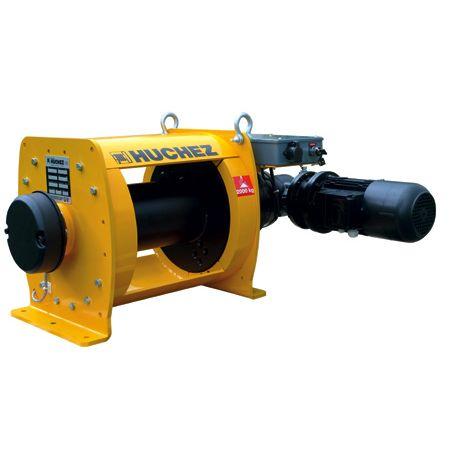Why a winch
We supply a wide range of manual and motorised winches (electric, thermal, etc.) for lifting and pulling applications in many sectors of activity (industry, mines and quarries, etc.).
Compared to other lifting equipment, the winch has several advantages: it can be used for both pulling and lifting operations. The wire rope on the drum can be several hundred metres long. This makes it possible to lift a load to a great height or to pull a load over a long distance.
The design of these winches can be adapted to a wide range of optional equipment.
Finally, to meet the most complex specifications, winches can also be custom designed.
The different types of winches
The use of a manual winch implies that the lifting or pulling/weighing of the load is linked to a manual human effort on a crank (or a steering wheel) located on the side or front of the winch.
Electric winches allow for the lifting or pulling/towing of larger loads. They are therefore more powerful, more comfortable to use and save time for the user.
Thermal winches (petrol or diesel engine) are autonomous and therefore very popular for all pulling/towing applications in places where electricity is not or hardly available (such as on a building site).
Vehicle winches are available in 12V and/or 24V depending on the model and are used for pulling/towing operations only. For any manoeuvre on an inclined plane, the effort to be developed must be increased.
All winches are supplied with a CE declaration and operating instructions.
Information for a price enquiry
In order to offer you the ideal winch for your application, the following information is useful:
- General description of the use of the winch, environment (indoor or outdoor, temperature, ATEX zone, etc.), constraints to be respected (weight, size, etc.)
- Lifting or pulling? In case of pulling, if the winch is used on an inclined plane, what is the angle of the slope?
- Weight of the load to be moved
- Frequency: occasional, moderate, intensive, maintenance?
- Manual or motorised winch? If motorised, single or three phase, voltage, frequency (Hz), 1 speed or variable speed drive, desired speed (in m/min), other specifications?
- Optional equipment, e.g. construction site frame, limit switches, secondary safety brake, grooved drum, multi wire rope drum, hands-free radio control, IP65 motor protection, special paint, etc.
Why a tirfor
The tirfor can work at any angle and without any limitation of reach. It is the real alternative to hoists and winches for manoeuvring on construction sites. By simply operating the lever, one person can move, lift and position considerable loads.








